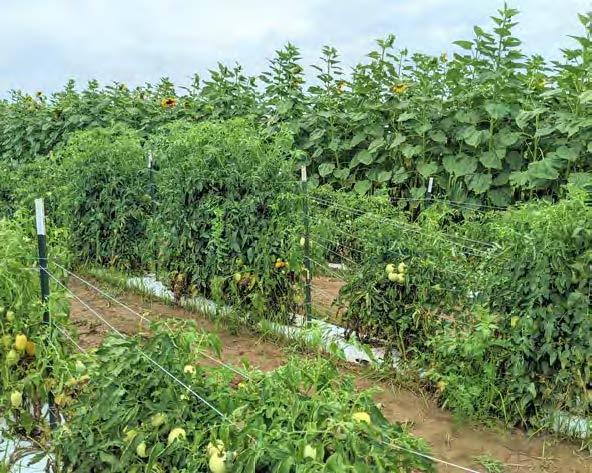Evaluation of Hot-Set Tomato Cultivars to Fill the Summer Slump in Southern Maryland
Ben Beale, Extension Educator, St. Mary’s County
Alan Leslie, Extension Educator, Charles County

During the 2022 growing season, we trialed 15 tomato cultivars that show promise as varieties that will produce high yields during the hottest periods of field tomato production in Maryland. This trial builds upon initial work done in 2021, where 13 tomato varieties were trialed. This year we included two new varieties: Bejo 3353 (Patsy), and Dixie Red. Patsy is a new variety that was developed specifically for growing conditions on the East Coast, and we were hopeful that it would have the same disease resistance characteristics as Bejo 3345 (Carole), but maybe produce larger fruit. Dixie Red was a variety favored by some of the local farmers in Southern MD, and was included in the trial to see how it stacked up against these newer releases.

Similar to the 2021 growing season, transplants were grown out by a commercial greenhouse grower in St. Mary’s County, and most of the transplants went to cooperating farmers to trial on their own operations. Survey results from these farmers are still being compiled and summarized. A formal, replicated trial was carried out at CMREC-Upper Marlboro, where multiple harvests were measured from each variety, and all fruit were counted and weighed according to size class. This field experiment was planted June 7 in four raised beds covered in white plastic, each row serving as a replicate. Varieties were randomly located within each replicate bed, and six transplants of each variety were planted together, separated from the neighboring variety by a yellow Roma tomato variety to help to separate neighboring varieties. Plants were trellised using the stake-and-weave system, and the indeterminate variety (Carole) received extra-tall posts to support a taller final plant size.

Growing conditions for 2022 were stressful for mid-season tomato production, and the plant growth and overall yields were lower than 2021. Immediately following transplanting, cool and cloudy conditions slowed the establishment and initial growth of the plants. Prolonged periods of extremely high temperatures during the harvest period apparently stressed the plants further, but also provided a good test of the heat tolerance of the different varieties. Harvests were conducted on four separate dates between August and September, where all fruit showing any breaking color were picked and separated into three size classes: Small/Medium (< 2.5”), Large/Extra Large (2.5” – 3.5”), and Jumbo (> 3.5”).
For the 2022 growing season, Bejo 3437 (Carrie) produced the highest total marketable yield, following its performance as the second highest yielder in 2021. Rounding out the top three yielders for 2022 were Bejo 3345 (Carole) and Red Morning. Interestingly, Dixie Red produced the lowest yields, though it did tend to produce relatively large fruit. In terms of largest average fruit size, Red Snapper produced the largest fruit, followed by STM 2255, XTM 5187 (Thunderbird), and Rambler. All of the varieties on trial tended to produce larger fruit than Red Mountain, a current grower standard.

Now most of these varieties have been tested for two field seasons, there are a few varieties that have emerged as consistently top performers under different categories. Bejo 3437 (Carrie) produces reliably high yields of good quality tomatoes with little cracking, splitting, or other damage that would render fruit unmarketable. The one drawback to this is that Carrie tends to produce relatively small fruit on average. Bejo 3345 (Carole) also produces relatively high yields of good quality fruit, but has the drawback of being an indeterminate variety. This variety may work well for certain types of high-tunnel production, but it produces a plant that is too large to manage in the field setting. STM 2255 is another variety that consistently produces high yields, even under less-than-ideal growing conditions. The largest fruit on average were produced by Rambler, Red Snapper, and XTM 5187 (Thunderbird), so if your target market is the jumbo size class, these varieties will produce more of those larger fruit. Finally, Scarlet Red is another variety that received honorable mention for producing a high proportion of marketable fruit, with relatively few culls over the two years in the trial.
Several of the varieties included in this trial are now recommended varieties for commercial production in the Mid-Atlantic Commercial Vegetable Production Recommendations guide. The new additions include: Bejo 3437 (Carrie), Bejo 3345 (Carole), Bejo 3353 (Patsy), Rambler, Roadster, and XTM 5187 (Thunderbird). Rambler and Roadster are recommended for early season production, while the rest are recommended for mid-season production.